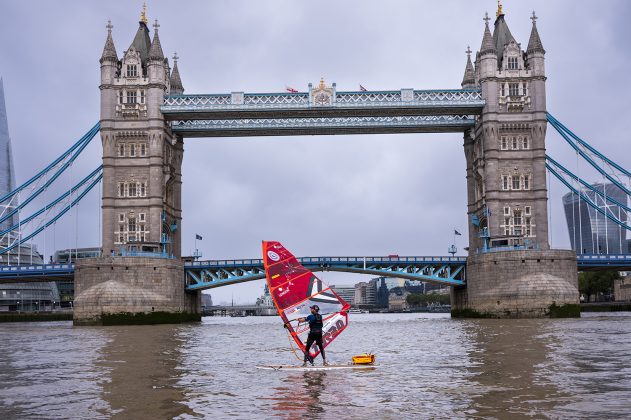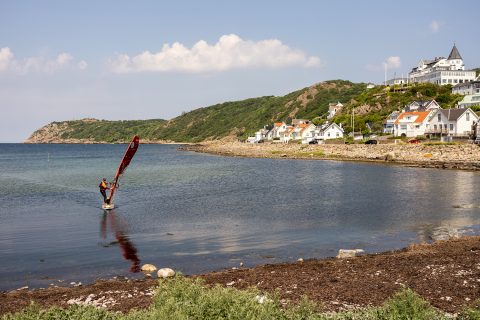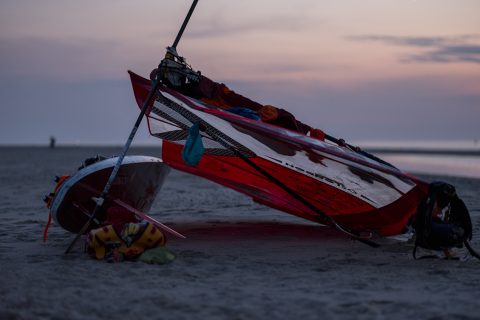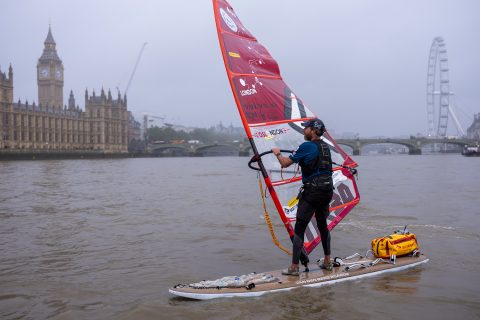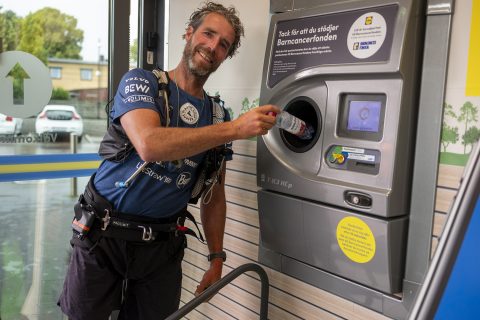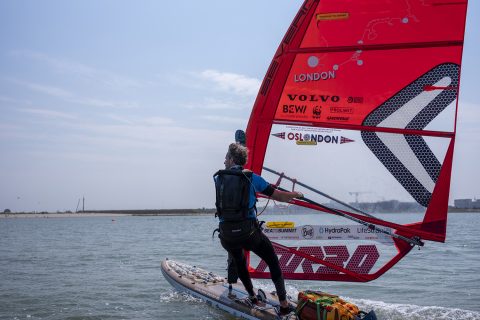Merijn Tinga: Plastic Soup Surfer
Dutchman Merijn Tinga, also known as the ‘Plastic Soup Surfer’, windsurfed 1800 kilometres on a board made of mushrooms and recycled materials from Oslo to London, to deliver a petition to have deposits on small plastic bottles introduced in the UK. He tells us more about the trip and his mission.
Words: Merijn Tinga // Photos: Marjolein Vinkenoog
During sailing trips around Sweden around seven years ago, I was struck by the amount of plastic waste lining local coasts. A closer look at the still legible labels, showed that the bottles carried by the ocean’s currents and wind had travelled across the sea all the way from the Netherlands and UK. Although these Scandinavian countries had active deposit systems in place for several years, they were still being impacted by waste originating from other countries. After seeing this, in 2016, I built a foil kite board from 60 littered bottles and kited it from Scheveningen to Lowestoft (180 km) across the North Sea. That expedition was also the start of a petition to have deposits on small plastic bottles introduced in the Netherlands. I ended up handing over 60,000 signatures to the Dutch parliament and having them sign a resolution I had written myself. That resolution became the political breakthrough and the basis to the policy that got deposits on plastic bottles instated in 2021.
Having had success in the Netherlands, I wanted to draw international attention to the effectiveness of deposit systems. This prevents millions of bottles and cans from ending up on the street and in nature as litter every year. I wanted to show how littered bottles from, for instance the River Thames, end up thousands of kilometres away because of sea currents and southwesterly winds. So I decided to bring those washed-up bottles back. Oslo is an iconic city, so it seemed like a great place to start from. We then went to London to collect littered plastic bottles from the Thames; bottles that would otherwise have floated down the river to the North Sea with the next tide. These bottles we then incorporated in the windsurf board we built. Ron van den Berg shaped the board. We used flaxen, recycled EPS, bio-epoxy and even mycelium (mushroom fibres).
- Merijn Tinga finds a landing spot
Preparations
It was at the end of October of last year that I first met shaper Ron van den Berg and asked him to help me build the board. In November I bought myself a second-hand Mistral Equipe to experiment with the baggage and loading, start training and get renewed longboard experience, as it had been twenty-five years since I last stood on a longboard. I am also very grateful for the advice I got from long-distance windsurfer Jonathan Dunnet. Finally in April of this year, my custom board was ready.
This was not my first long distance expedition. I once stand-up paddled down the river Rhine from source to sea, wind foiled from Le Havre to the Netherlands and cycled to Morocco (and back) with a kite board behind my bike.
I expected this expedition from Oslo to London to become my most arduous and intense journey to date. Around six weeks before the mission, my training comprised of daily swimming in open water and cycling. I would go windsurfing when there was more than force four winds and started doing 50-kilometre trips along the Dutch coast starting in Katwijk, close to where I live. I also checked the route and worked out how many kilometres I would have to do each day.
- Camp spot
Kit
I used a board made by Ron van den Berg who was the man behind many famous shapes in the nineties. He built a board for me that was a copy of one of his raceboard shapes. My board was a little wider and more volume, so I could handle it in waves. I used a Severne Turbo 8.6m as my sail. I thought about bringing a spare fin since I snapped one in training, but I ended up leaving it at home. I brought some tools, repair materials and tape to fix my sail. I also took a GPS tracker, a flare and with my watch I could tell my speed, so I knew how fast I was going and I had a navigation app. I have sailed around the UK and Norway in the past, so I have a lot of yacht sailing experience and I think I really needed that. I also had a handheld compass, so with all these items, I could navigate, know my time, speed and bearings. There was also an SOS button on my GPS for if anything that did go wrong. In order to minimize what I was wearing I took a SUP ‘long john’ wetsuit, a hat, a long sleeved thermal neoprene top and a hardshell normal jacket over that. I also wore a t-shirt under all of that and five-finger shoes, as well as sunglasses and plenty of sunscreen. I could not take a tent obviously, so I slept underneath my sail.
Highs and lows
The highs are the moments when you are at one with your board. I was out in the middle of the sea between the waves and the moments I felt in control felt great. I also love camping in the wild and never knowing where you will end up sleeping. It would just depend on the wind each day how far you would make it. I would haul my board onto the shore and land on a beach or a small rocky island. I also had a paddle with me for when there was no wind to help me get in. I also used that paddle to hold up my sail as a tent. It felt great to wake up in the middle of nature. I was very dependent on the wind, tides and currents. That makes you feel very small, but it also makes you feel at one with nature. That was one of my drives in the first place, to experience being at one with your body as I persevered towards my goal.
I had a few low and scary moments when I was between rocks and in waves and I had to navigate between some big rocks to find safety a few times. In the Netherlands I had a moment where the current was pulling me into an industrial harbour. There was no place for me to go. The current was against me and I just could not make any ground. It was very rough and very windy. I was just windsurfing back and forth for two hours going nowhere. Eventually the current relaxed, the tide turned and I moved onwards. I had to get into a state of acceptance.
People did not believe me when I told them that I had windsurfed from Oslo and that I was on my way to London. Their jaws dropped! It was always surprising to see how people reacted. Many people would invite me for food, or restaurants would open up their kitchens for me. I also saw plenty of wildlife jumping up right next to my board.
- Merijn Tinga arriving in London
London
The whole mission was to try and get a deposit return system in the UK. for plastic bottles. I am hoping that the UK speeds up their process. I have been campaigning for a deposit return system for a very long time. I was in contact with several UK. campaigns such as Surfers Against Sewage (SAS) etc. I had a lot of meetings with these organizations from January onwards. SAS arranged a meeting with the environment minister in Westminster. I was standing there in my wetsuit amongst all these minsters, politicians and associates in their three-piece suits. It felt like an achievement and that they were listening because of my story and attire. Of course, we had a letter urging them to speed up the deposit return scheme in the UK. They invited me back later in the year, to hand over the petition again to the next responsible minister. I will be back in the UK with my story. The BBC were filming when I arrived and windsurfed on the Thames at Westminster and in front of Tower Bridge. The BBC made a prime-time news item on it. So, I managed to get a lot of attention as well as radio interviews also. I have not finished yet!
- Merijn Tinga
Future plans
I have paddled the length of the Rhine and also done some kite surfing, kite foiling and wing foiling missions, but doing it on a windsurfing board with your gear, on your own, with no escort boats, just you and the wind, that feels really good. So, I would love to windsurf from Leiden (where I live – close to Scheveningen) to Loch Ness next summer and then take a water sample from the middle of Loch Ness to demonstrate that a monster is really there – namely microplastics!
- Merijn Tinga


